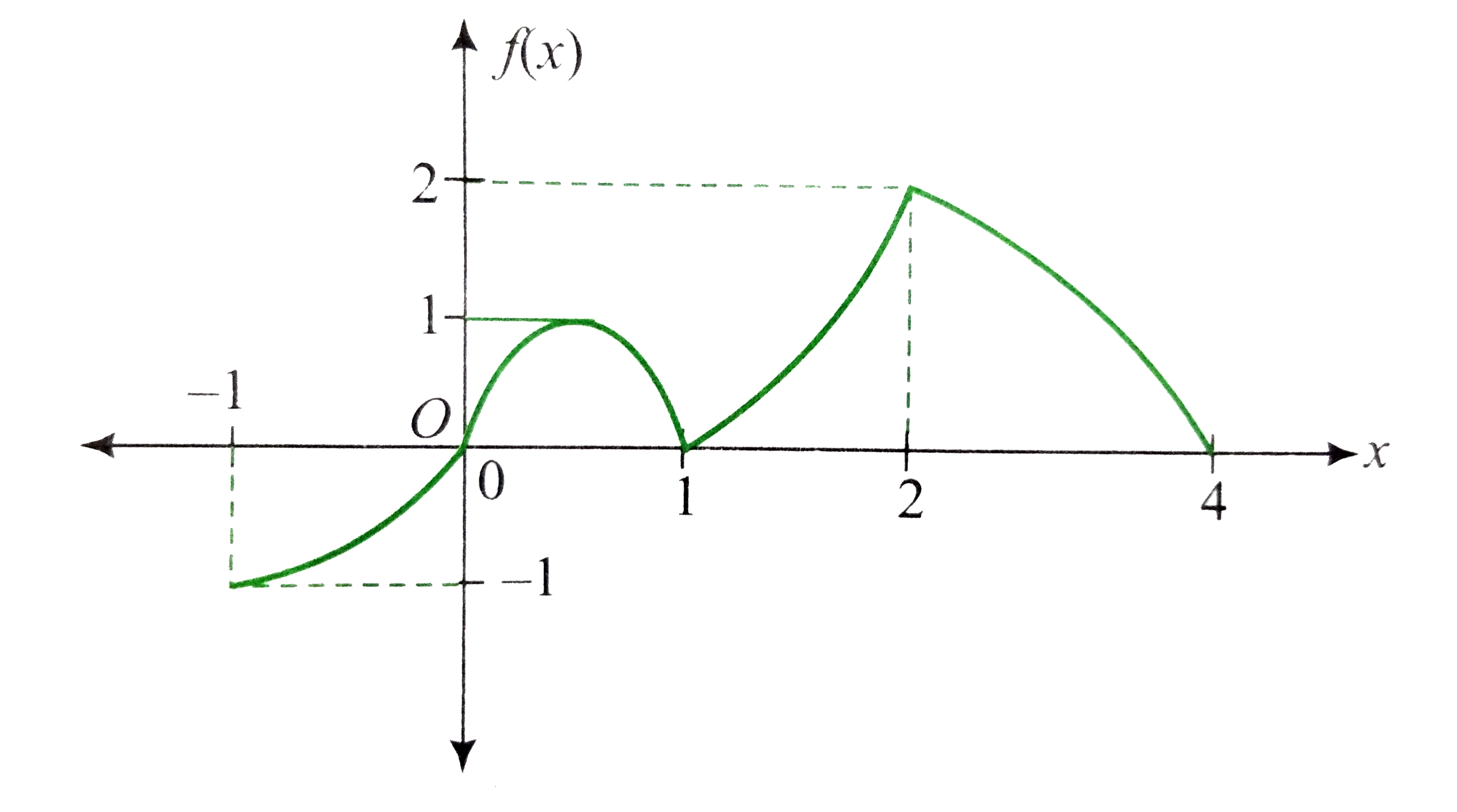The graph of a function fx) which is defined in [-1, 4] is shown in the adjacent figure. Identify the correct statement(s). (1) domain of f(|x|)−1)is[−5,5] (2) range of f(|x|+1) is [0,2] (3) range of f(−|x|) is [-1,0] (4) domain of f(|x|)is[−3,3]
To solve the problem, we need to analyze the statements about the function f(x) defined on the interval (−1,4) based on the provided graph. Let's evaluate each statement step by step.
Step 1: Analyze the Domain of f(|x|)−1
1. The function f(x) is defined for x∈(−1,4).
2. The expression |x| takes values from 0 to 5 when x is in the range of (−5,5).
3. Therefore, f(|x|) will be defined for |x| values in (−1,4), which corresponds to x values in the interval (−4,4).
4. Since we are looking for f(|x|)−1, the domain remains the same, which is (−4,4).
Conclusion: The domain of f(|x|)−1 is (−4,4), not (−5,5).
Step 2: Analyze the Range of f(|x|+1)
1. The expression |x|+1 takes values from 1 to 5 when x is in the range of (−4,4).
2. The function f(x) is defined from (−1,4) and takes values from (−1,2).
3. For |x|+1, the minimum value is 1 (when x=0) and the maximum value is 5 (when x=4).
4. Therefore, we need to evaluate f(x) for x in the range (1,4).
5. The corresponding range of f(x) for x∈(1,4) is from f(1) to f(4). Assuming f(1) is 0 and f(4) is 2, the range of f(|x|+1) is (0,2).
Conclusion: The range of f(|x|+1) is (0,2).
Step 3: Analyze the Range of f(−|x|)
1. The expression −|x| takes values from 0 to -5 when x is in the range of (−5,5).
2. The function f(x) is defined from (−1,4) and takes values from (−1,2).
3. For −|x|, the maximum value is 0 (when x=0) and the minimum value is -5 (when x=5).
4. Therefore, we need to evaluate f(x) for x in the range (−1,0).
5. The corresponding range of f(x) for x∈(−1,0) is from f(−1) to f(0). Assuming f(−1) is -1 and f(0) is 0, the range of f(−|x|) is (−1,0).
Conclusion: The range of f(−|x|) is (−1,0).
Step 4: Analyze the Domain of f(|x|)
1. The expression |x| takes values from 0 to 5 when x is in the range of (−5,5).
2. The function f(x) is defined from (−1,4).
3. Therefore, |x| must be in the range (−1,4), which corresponds to x values in the interval (−4,4).
Conclusion: The domain of f(|x|) is (−4,4), not (−3,3).
Final Summary of Statements
1. Domain of f(|x|)−1 is (−5,5) - Incorrect
2. Range of f(|x|+1) is (0,2) - Correct
3. Range of f(−|x|) is (−1,0) - Correct
4. Domain of f(|x|) is (−3,3) - Incorrect
Correct Statements
- Statement 2 and Statement 3 are correct.
2. The expression |x| takes values from 0 to 5 when x is in the range of (−5,5).
3. Therefore, f(|x|) will be defined for |x| values in (−1,4), which corresponds to x values in the interval (−4,4).
4. Since we are looking for f(|x|)−1, the domain remains the same, which is (−4,4).
2. The function f(x) is defined from (−1,4) and takes values from (−1,2).
3. For |x|+1, the minimum value is 1 (when x=0) and the maximum value is 5 (when x=4).
4. Therefore, we need to evaluate f(x) for x in the range (1,4).
5. The corresponding range of f(x) for x∈(1,4) is from f(1) to f(4). Assuming f(1) is 0 and f(4) is 2, the range of f(|x|+1) is (0,2).
2. The function f(x) is defined from (−1,4) and takes values from (−1,2).
3. For −|x|, the maximum value is 0 (when x=0) and the minimum value is -5 (when x=5).
4. Therefore, we need to evaluate f(x) for x in the range (−1,0).
5. The corresponding range of f(x) for x∈(−1,0) is from f(−1) to f(0). Assuming f(−1) is -1 and f(0) is 0, the range of f(−|x|) is (−1,0).
2. The function f(x) is defined from (−1,4).
3. Therefore, |x| must be in the range (−1,4), which corresponds to x values in the interval (−4,4).
2. Range of f(|x|+1) is (0,2) - Correct
3. Range of f(−|x|) is (−1,0) - Correct
4. Domain of f(|x|) is (−3,3) - Incorrect
- Statement 2 and Statement 3 are correct.
Similar Questions
Knowledge Check
The domain of the function f(x)=1√4+3sinx is :
ARB[−π2,π2]CR−{2nπ,n∈I}D(0,π2)The domain of the function f defined by f(x)=1√|x|−x is
AR−[3,−2]BR−[−3,2]C[R−[3,−2]DR−(−3−2)
If f(x) is defined on [0,1], then the domain of f(3x2) , is
View SolutionConsider the real-valued function satisfying 2f(sinx)+f(cosx)=x. then the (a)domain of f(x)isR (b)domain of f(x)is[−1,1] (c)range of f(x) is [−2π3,π3] (d)range of f(x)isR
View SolutionThe function f(x) is defined on [0, 1]. Find domain of definition of (tan x), f (sin x), f(2x - 3).
View SolutionLet f be a function defined on [0,2]. Then find the domain of function g(x)=f(9x2−1)
View SolutionConsider the real-valued function satisfying 2f(sinx)+f(cosx)=x. then the domain of f(x)isR domain of f(x)is[−1,1] range of f(x) is [−2π3,π3] range of f(x)isR
View SolutionDomain of the function f defined by f(x) =√x−1 is given by
View Solution

